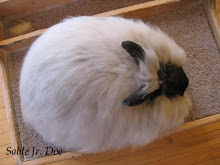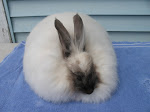Another post from the old blog. Please be patient while I switch them all over!:-)
Today I thought I would write an entry to try to answer the question of what a 'Grand Champion' is and what significance should be attached to this title. I suppose this is a topic that may be viewed as political and in some ways it certainly is, but since there are many people who are new or looking to purchase new stock for the first time in the rabbit world, it is important to understand what 'titles' and 'legs' mean, and how important they are in assessing the quality of a rabbit line.
First of all, a Grand Championship can only be earned when a rabbit has had 3 wins which have earned him/her 3 legs. A 'win' qualifies as a 1st place in any class, or a 1st place out of several classes combined, as in the case of BOV (Best of Variety), BOS (Best Opposite Sex), and BOB (Best of Breed). A 'leg' can only be earned toward the Grand Championship (GC) if there are at least 5 rabbits in any class being shown by at least 3 exhibitors. IF there are less than this number being shown in a class OR in the whole show, a rabbit can still be awarded 1st place or BOB and proceed to the Best in Show table, but the win will not technically 'count' and the rabbit will not be able to earn a leg towards the championship with it.
There are many instances in which a GC may be earned or 'engineered' (for lack of a better word), and it is very important to keep this possibility in mind when looking at the pedigree of a prospective purchase. A GC is NOT necessarily a superior rabbit, and a rabbit who readily earns a championship in one area may not necessarily be able to accomplish the same feat in a location with more competition or a higher level of quality in the breed.
Since Angoras are relatively uncommon in the US there will naturally be certain areas where they are numerous, and other places where they are practically non-existent on the local show circuit. The ethics of this practice may be controversial, but there is no rule against entering unregistered rabbits in a show under more than one name, so 'competition' can often be artifically created when 1 or more breeders enter their animals in such a way as to qualify the winning rabbit for a leg. I am not attempting to pass judgment on this practice, but merely pointing out that it is certainly possible to manufacture impressive pedigrees without actually showing an animal under rigorous competition. Always be sure to question breeders as to what the level of competition normally is at their shows, and whether or not there were more than 3 exhibitors physically present at the shows where their Champions were produced.
Indications of the true quality of a line can be observed in the following situations:
1-The breeder's animals regularly win or place in the top half of sizable classes with large numbers of exhibitors in local shows.
2-The breeder's animals regularly win or place in the top ranks of their classes at National shows, particularly the ARBA Convention.
3-The breeder occasionally or frequently wins Best in Show in the Open class (which is awarded out of every breed of rabbit in a show)
4-The breeder consistently shows quality stock and places well in stiff competition with different animals, not just the same rabbits week in and week out over several consecutive show seasons.
Again, I do not want to insinuate that people who do NOT show in highly populated areas do not have animals of high quality, OR that people who do not show or earn GCs at all are not raising excellent rabbits. Indeed, there are some breeders whose rabbits have never been shown, granded, or even registered who often have better stock than the breeders who show every weekend and have very fancy pedigrees. It is purely a matter of preference whether a person chooses to submit their rabbits to showtable evaluation or not, and when push comes to shove the true measure of quality is in the general reputation of the breeder and the quality of the animals they breed. A reputable breeder will always answer questions directly and will never knowingly misrepresent their stock. For those who DO show, the good thing about winnings on a pedigree is that the buyer can use this information to dissect a line further and interpret the meanings of titles that were assigned.
In conclusion, there will always be honest breeders, and not so honest breeders:(. Research sources for stock by contacting breeders with relevant questions. Speak to people who can refer you to reputable rabbit raisers, and use common sense when faced with a situation (or breeder) who does not seem altogether truthful. It is important to strive for as many GC quality animals as possible in your breeding program, but be aware--also--of what a title means and doesn't mean. Do not be fooled into thinking that a highly decorated animal is necessarily any better than the one who has rarely been shown or has never seen the outside of a barn. In the final reckoning it is the overall quality of a line that counts, not the number of awards or legs a certain rabbit has accumulated. EVERYTHING is relative, remember. Especially in the show world:^).
Also, here are some current events before I finish this post:). I have been busy grooming mature coats this week and culling my herd down to final numbers before the next litters come, and I took several pictures of some of the keepers. My oldest juniors are now approaching 5-6 months of age with the rest being younger, and I've bred 3 more does for PA Convention jrs. Also, speaking of conventions! The big National ARBA Convention starts this week and I'm sure people are frantically getting ready and grooming their bunnies before the judging starts, <:-O. Obviously I am still at home and not one of those people, LOL, but I may attend 2010 and will most definitely be at 2011, since it should be swinging back to the east coast by then and there will be no excuse not to go, LOL.
This is a beautiful Fawn buck out of Morwenna's last litter who I went back and forth about selling but who I have now decided to keep because of his great balance and type.

And this is a horrible picture of a Chestnut buck tentatively named Angelo. Sorry about the blue lines. Argh!

And this is one of two Pearl does out of Oomi who are so close in quality that I kept them both to see how they develop:


And this is the very best doe/rabbit that has come out of last summer's breedings. I don't know what her senior coat will look like so I may have to eat my words yet, LOL, but as of now she has the best type, balance, and wool out of everyone, and I am hoping that she'll do well in the future. Her name is Spang's Magdeline:


And next here, believe it or not, is an F3 NZ/FA cross doe in her first Sr. coat! She has not grown it in all the way yet and I don't think her texture is as perfect as it should be, but she should make nice babies for the next generation, and she will be ready for the showtable if her coat looks good in a few months.


And last of all is the pick of Morwenna/Oberon's last litter, a very promising Tort doe at 4 months of age.

Have a great week and best of luck to all the Convention goers!!!!:^)

























